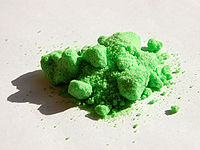Nickel(II) chloride
 Hexahydrate
|
|
 |
|
 Anhydrous
|
|
| Names | |
|---|---|
|
IUPAC name
Nickel(II) chloride
|
|
| Other names
Nickelous chloride, nickel(II) salt of hydrochloric acid
|
|
| Identifiers | |
|
7718-54-9 7791-20-0 (hexahydrate) |
|
| 3D model (Jmol) | Interactive image |
| ChEBI |
CHEBI:34887 |
| ChemSpider |
22796 |
| ECHA InfoCard | 100.108.731 |
| EC Number | 231-743-0 |
| KEGG |
C14711 |
| PubChem | 24385 |
| RTECS number | QR6480000 |
|
|
|
|
| Properties | |
| NiCl2 | |
| Molar mass | 129.5994 g/mol (anhydrous) 237.69 g/mol (hexahydrate) |
| Appearance | yellow-brown crystals deliquescent (anhydrous) green crystals (hexahydrate) |
| Odor | odorless |
| Density | 3.55 g/cm3 (anhydrous) 1.92 g/cm3 (hexahydrate) |
| Melting point | 1,001 °C (1,834 °F; 1,274 K) (anhydrous) 140 °C (hexahydrate) |
|
anhydrous 67.5 g/100 mL (25 °C) 87.6 g/100 mL (100 °C) hexahydrate 123.8 g/100 mL (25 °C) 160.7 g/100 mL (100 °C) |
|
| Solubility | 0.8 g/100 mL (hydrazine) soluble in ethylene glycol, ethanol, ammonium hydroxide insoluble in ammonia, nitric acid |
| Acidity (pKa) | 4 (hexahydrate) |
| +6145.0·10−6 cm3/mol | |
| Structure | |
| Monoclinic | |
| octahedral at Ni | |
| Thermochemistry | |
|
Std molar
entropy (S |
107 J·mol−1·K−1 |
|
Std enthalpy of
formation (ΔfH |
−316 kJ·mol−1 |
| Hazards | |
| Safety data sheet | Fischer Scientific |
|
EU classification (DSD)
|
Carc. Cat. 1 Muta. Cat. 3 Repr. Cat. 2 Toxic (T) Irritant (Xi) Dangerous for the environment (N) |
| R-phrases | R49, R61, R23/25, R38, R42/43, R48/23, R68, R50/53 |
| S-phrases | S53, S45, S60, S61 |
| NFPA 704 | |
| Flash point | Non-flammable |
| Lethal dose or concentration (LD, LC): | |
|
LD50 (median dose)
|
105 mg/kg (rat, oral) |
| Related compounds | |
|
Other anions
|
Nickel(II) fluoride Nickel(II) bromide Nickel(II) iodide |
|
Other cations
|
Palladium(II) chloride Platinum(II) chloride Platinum(II,IV) chloride Platinum(IV) chloride |
|
Related compounds
|
Cobalt(II) chloride Copper(II) chloride |
|
Except where otherwise noted, data are given for materials in their standard state (at 25 °C [77 °F], 100 kPa).
|
|
|
|
|
| Infobox references | |
Nickel(II) chloride (or just nickel chloride), is the chemical compound NiCl2. The anhydrous salt is yellow, but the more familiar hydrate NiCl2·6H2O is green. Nickel(II) chloride, in various forms, is the most important source of nickel for chemical synthesis. The nickel chlorides are deliquescent, absorbing moisture from the air to form a solution. Nickel salts are carcinogenic.
The largest scale production of nickel chloride involves the extraction with hydrochloric acid of nickel matte and residues obtained from roasting refining nickel-containing ores.
Nickel chloride is not usually prepared in the laboratory because it is inexpensive and has a long shelf-life. Heating the hexahydrate in the range 66-133.°C gives the yellowish dihydrate, NiCl2·2H2O. The hydrates convert to the anhydrous form upon heating in thionyl chloride or by heating under a stream of HCl gas. Simply heating the hydrates does not afford the anhydrous dichloride.
The dehydration is accompanied by a color change from green to yellow.
In case one needs a pure compound without presence of cobalt, nickel chloride can be obtained cautiously heating hexammine nickel chloride:
NiCl2 adopts the CdCl2 structure. In this motif, each Ni2+ center is coordinated to six Cl− centers, and each chloride is bonded to three Ni(II) centers. In NiCl2 the Ni-Cl bonds have "ionic character". Yellow NiBr2 and black NiI2 adopt similar structures, but with a different packing of the halides, adopting the CdI2 motif.
In contrast, NiCl2·6H2O consists of separated trans-[NiCl2(H2O)4] molecules linked more weakly to adjacent water molecules. Only four of the six water molecules in the formula are bound to the nickel, and the remaining two are water of crystallisation.Cobalt(II) chloride hexahydrate has a similar structure. The hexahydrate occurs in nature as the very rare mineral nickelbischofite.
...
Wikipedia

